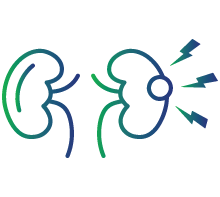
Culture Automated Blood Aerobic
Culture Automated Blood Test
Culture-automated blood test is used to detect the presence of aerobes (bacteria that require oxygen to grow) in the blood. Automated blood cultures are more efficient and sensitive than routine blood cultures. This test identifies the presence of infection and its causative organisms in the blood.
An automated blood culture test is used throughout the treatment process to detect blood infections. Healthcare providers order this test to identify blood infections caused by aerobic bacterial species like E. coli, Staphylococcus aureus, group B Streptococcus (GBS), and Enterococcus faecalis, which can lead to sepsis, a life-threatening chronic condition.
Who should be tested?
Symptoms of sepsis (infection in the blood) that require an automated blood culture test include:

Fever

Chills

Fast heartbeat

Rapid breathing

Low blood pressure

Confusion

Decreased urination

Inflammation throughout the body

Infections (affecting heart valves, bones, spinal cord or brain)

Organ failure
What is culture- an automated blood test used for?
Culture-automated blood test helps in the following conditions:

Testing for a bacteria, fungus or virus in the blood to confirm that an infection is the cause of an individual’s symptoms

Determining the specific type of bacteria causing an infection

Assessing the severity of the infection

Planning the treatment to check which antibiotic works best against the specific bacteria

Monitoring how well the infection is responding to the particular treatment
Test Preparation
No special preparation is required for this test. Some antibiotics might affect your test results. So, make sure your doctor is aware of any antibiotics that you have taken before the test.
Interpretation of the Test Results
Positive test result
If the test results were positive for a culture-automated blood test, it means the presence of infection-causing bacteria or other germs in your blood sample. This may lead to sepsis; it is a medical emergency, and you will be admitted to a hospital for treatment. Sometimes, an abnormal result may be caused by contamination of the blood sample. It means that the bacteria identified may have come from your skin or from the lab equipment instead of your blood, giving a false-positive result.
Negative test result
If the test results were negative for a culture-automated blood test, it means the absence of infection-causing bacteria or other germs in your blood sample.
FAQs
How is the culture-automated blood test performed?
During this blood test, a healthcare professional will take a small amount of blood from a vein in your arm using a small needle, which is then collected in a test tube or vial. The site where blood will be drawn for the blood sample is cleaned with an antiseptic like chlorhexidine. This reduces the chance of bacterial contamination causing a false-positive result. The collected sample is then sent to a laboratory for analysis.
What are the risks associated with a culture-automated blood test?
There are no known risks. During a blood test, one may experience minor pain or bruising where the needle was inserted, but most symptoms will subside quickly.
What is the turnaround time (TAT) for the culture-automated blood test?
Test results for culture-automated blood are usually available within 5–6 working days. The sample is kept in a special environment to promote microorganism growth. The microorganisms in the sample specimen may take some time to grow. Test results might be mailed or made available online through health portals. Your doctor might also contact you by phone or email to review your test findings or arrange a follow-up appointment.
Why do I need a follow-up culture-automated blood test?
Based on the results of your culture-automated blood test, you may require follow-up testing if your test results are negative but you have symptoms of an infection. Since a culture-automated blood test cannot detect all germs, other types of tests or repeat blood culturing tests may be ordered to detect the cause or spread of infection.
Once the treatment has started, you may need follow-up blood culture tests to see if the treatment is working against the specific microorganism and if your infection is getting better.
Should I worry if my test results are positive?
A positive culture-automated blood test result could mean that you have a bacterial or yeast infection in your blood. There is no need to worry; the infection will subside within a week of antibiotic treatment.
It is advisable to consult your healthcare professional for an appropriate diagnosis and a proper treatment plan. Depending on the kind of organism discovered in your blood, another test called a sensitivity or susceptibility test is performed to determine the specific medication that will work best against the organism.

